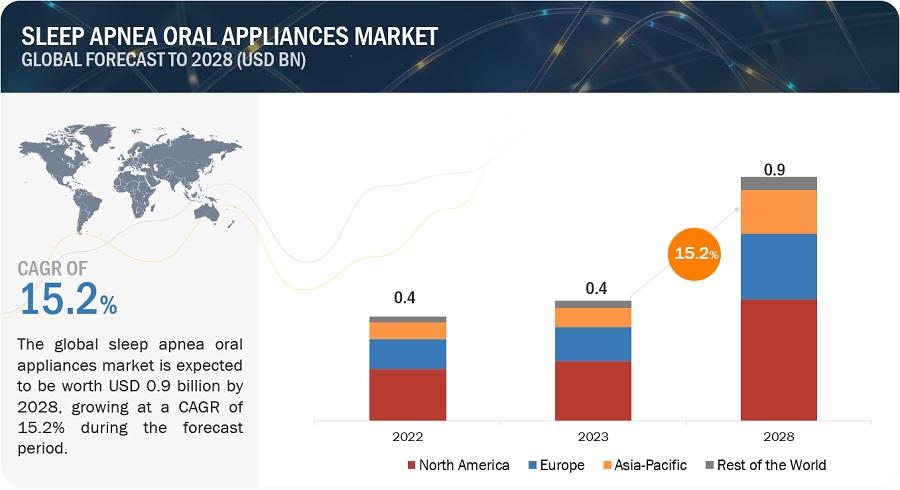Sleep apnea, a potentially serious sleep disorder, affects millions of individuals worldwide. Characterized by repeated interruptions in breathing during sleep, it can lead to severe health complications if left untreated. Traditional treatments such as Continuous Positive Airway Pressure (CPAP) therapy are effective but often suffer from poor patient compliance due to discomfort and inconvenience. As a result, the market for oral appliances, specifically designed to manage sleep apnea, has grown significantly. Among these, Mandibular Advancement Devices (MAD) and Tongue-Retaining Devices (TRD) are leading the charge, offering viable alternatives for patients seeking comfort and ease of use.
Sleep Apnea Oral Appliances Market by Product (Mandibular Advancement Devices (MAD), Tongue-Retaining Devices (TRD)) - Global Forecast to 2028
The sleep apnea oral appliances market was estimated to be worth $0.4 billion in 2023 and is projected to reach $0.9 billion by 2028, growing at a compound annual growth rate (CAGR) of 15.2%
Download a PDF Brochure: https://www.marketsandmarkets.com/pdfdownloadNew.asp?id=105423877
Market Overview
The global sleep apnea oral appliances market has seen robust growth over the past decade. This growth is driven by increased awareness of sleep disorders, advancements in dental technology, and a rising preference for non-invasive treatment options.
Mandibular Advancement Devices (MAD)
Mandibular Advancement Devices (MAD) are the most commonly used oral appliances for treating obstructive sleep apnea (OSA). These devices work by repositioning the lower jaw (mandible) forward, which helps to keep the airway open during sleep. This forward positioning prevents the tongue and soft tissues in the throat from collapsing and obstructing the airway.
Market Share and Growth
MADs hold the largest share of the sleep apnea oral appliances market. Their popularity can be attributed to several factors:
· Effectiveness: Clinical studies have shown that MADs are effective in reducing the severity of OSA in many patients. They are particularly beneficial for those with mild to moderate sleep apnea.
· Patient Compliance: Compared to CPAP machines, MADs are less intrusive and more comfortable to wear, leading to higher patient compliance.
· Customization: MADs are often custom-made to fit the patient’s mouth, ensuring better comfort and efficacy.
Key Players
Several companies dominate the MAD market, including SomnoMed, ResMed, and Airway Management Inc. These companies invest heavily in research and development to enhance the design and functionality of their devices, ensuring better patient outcomes.
Tongue-Retaining Devices (TRD)
Tongue-Retaining Devices (TRD) offer an alternative approach to managing sleep apnea. These devices function by holding the tongue in a forward position using suction, thereby preventing it from collapsing back into the airway.
Market Share and Growth
While TRDs have a smaller market share compared to MADs, their growth is noteworthy. They cater to a specific subset of patients who may not respond well to MADs or CPAP therapy. Factors contributing to the growth of the TRD market include:
· Simplicity: TRDs are relatively simple in design and easy to use, which can be appealing to patients who prefer minimal intervention.
· Affordability: Generally, TRDs are less expensive than custom-made MADs, making them an attractive option for cost-conscious patients.
· Effectiveness for Specific Cases: TRDs can be particularly effective for patients whose primary issue is tongue-based airway obstruction.
Key Players
Major players in the TRD market include companies like AveoTSD and Snorex. These companies focus on improving the design and comfort of TRDs to enhance patient adherence and outcomes.
Comparative Analysis
While both MADs and TRDs serve the same ultimate purpose—keeping the airway open during sleep—their mechanisms and user experiences differ significantly.
Mechanism of Action:
· MADs reposition the lower jaw, which indirectly stabilizes the airway.
· TRDs directly target the tongue, using suction to keep it in place.
Patient Comfort and Compliance:
· MADs are custom-fit, often resulting in higher comfort and compliance.
· TRDs, though simpler, may be less comfortable for some due to the suction mechanism.
Cost:
· MADs, especially custom-fitted ones, tend to be more expensive.
· TRDs are generally more affordable but may require periodic replacement.
Future Trends
The sleep apnea oral appliances market is poised for continued growth, driven by several emerging trends:
· Technological Advancements: Innovations in materials and design are making oral appliances more comfortable and effective. For instance, 3D printing technology is being used to create highly customized and precise devices.
· Increased Awareness: Ongoing public health campaigns and greater awareness among healthcare providers about sleep apnea and its treatment options are expected to drive market growth.
· Regulatory Support: Favorable regulatory environments and the approval of new products are likely to enhance market dynamics.
Conclusion
The sleep apnea oral appliances market, with a particular focus on MADs and TRDs, is experiencing significant growth. These devices offer effective, non-invasive alternatives to traditional CPAP therapy, addressing a critical need for better patient compliance and comfort. As technological advancements continue to improve the efficacy and user experience of these devices, the market is expected to expand further, providing hope and relief to millions of sleep apnea sufferers worldwide.



